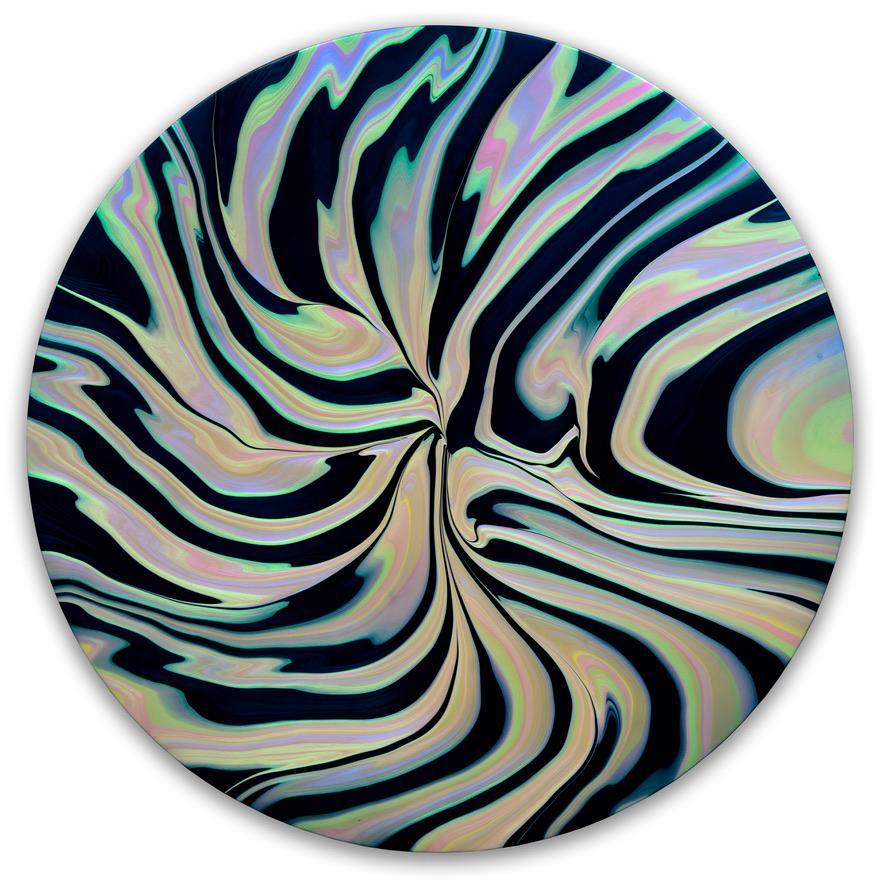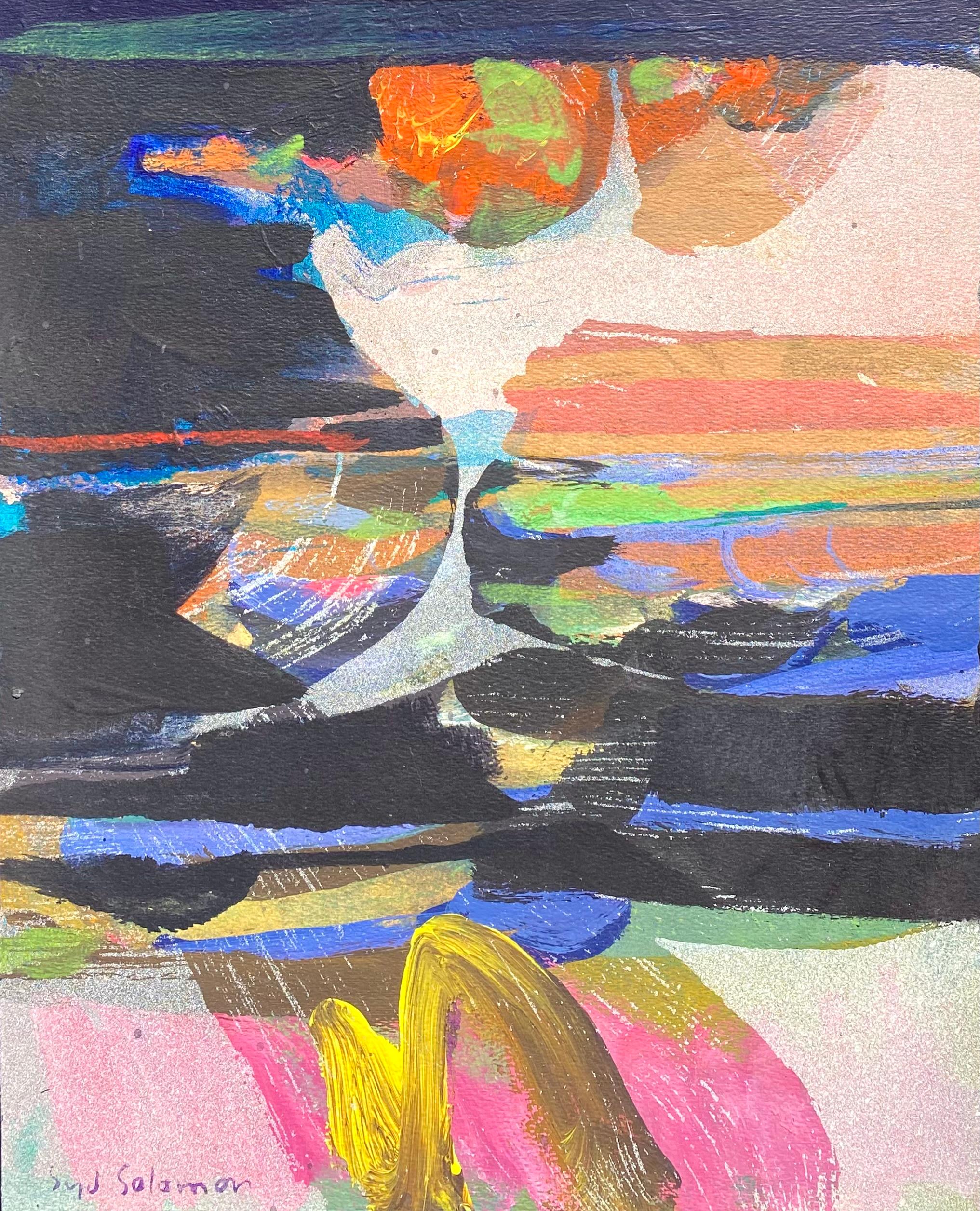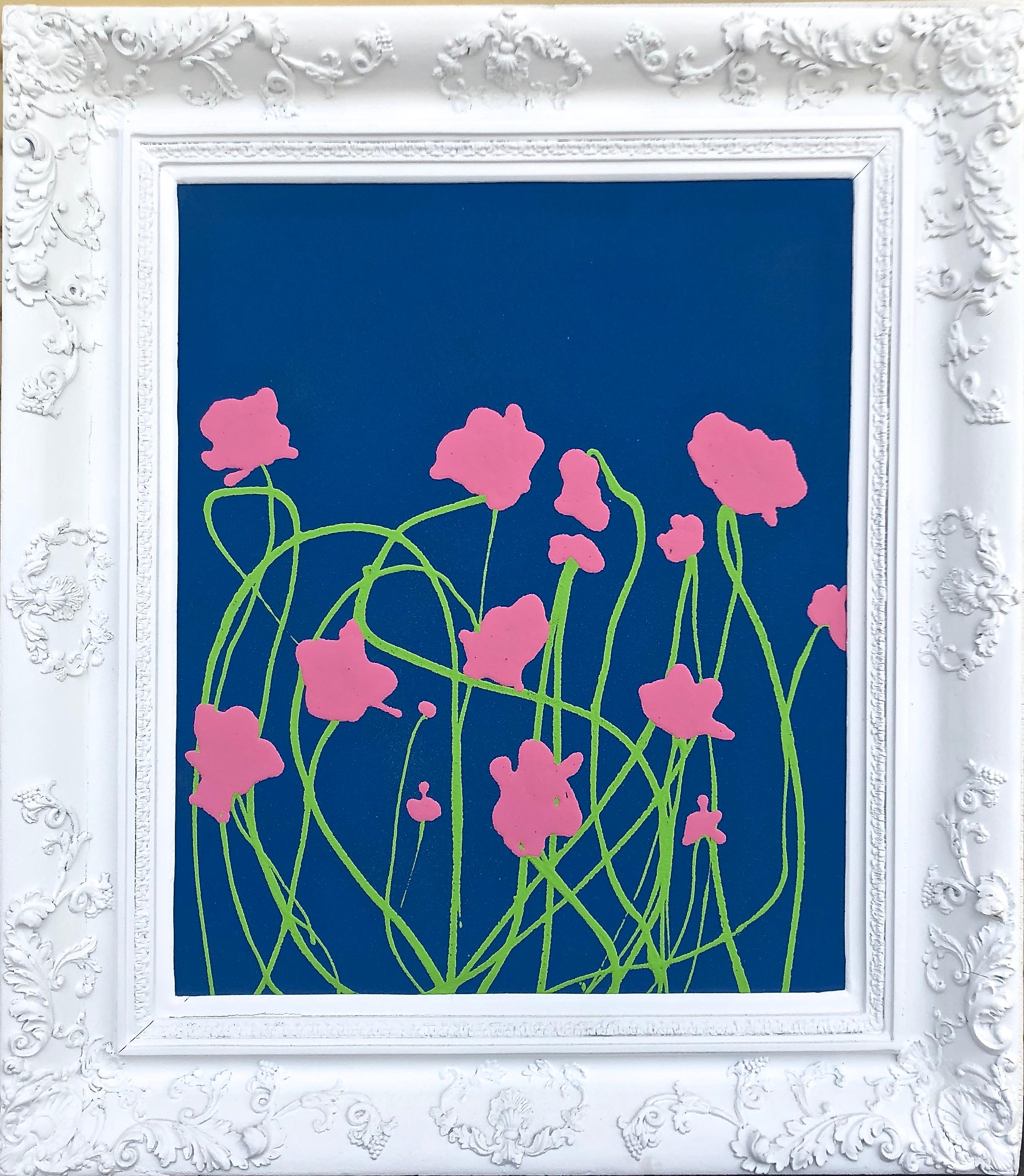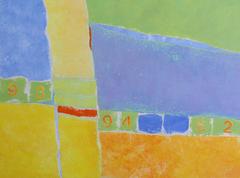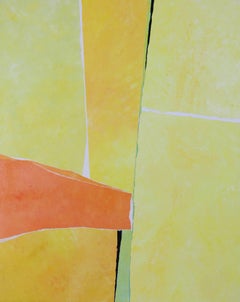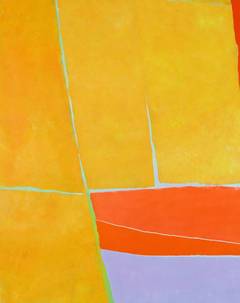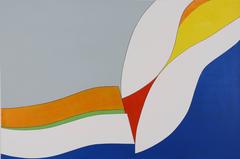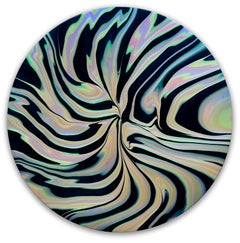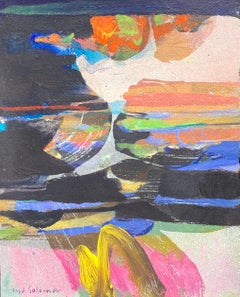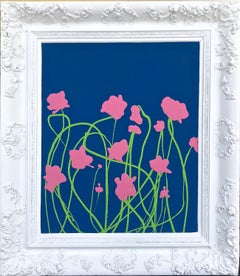Items Similar to Untitled
Want more images or videos?
Request additional images or videos from the seller
1 of 4
Charles MiesmerUntitled2011
2011
About the Item
Miesmer began painting in the open air during the summers in Nantucket. Using a pad of Arches paper as an easel and working out of the back of his pickup truck, the quietude and peace he found in the landscape of sea grass, dunes and the ocean resulted in a series of intimately scaled and spontaneously sketched oil pastels. These found an immediate and receptive audience, and quickly led to the realization that he needed more space, and needed to work bigger. Before long he built a studio at his home in Southport, and started a period of more serious work. One day soon after this his daughter, Lily, spilled
paint on the pages of a textbook. The visual result of this accident fascinated him, the reveal of words behind layers of color, and he began experimenting with it. This "experiment" has lasted for 15 years, in which individual pages from books have been painted, stained, sanded, bleached and transformed well past the intent of their original publishers and then arranged in either grid-like or random patterns on canvas, creating a surface of shifting and atmospheric fields of color. This technique is illustrated in Seawater 1, Coatue 2, and Anguilla 1, which present simplified views of land, sea, and sky yet still retain the traditional divisions of space and a clear horizon line. In contrast, Three Field Collage #2 and Meade's Bay reveal a greater abstraction of the landscape and further blurring of the natural divisions of space. An even greater simplification of this is achieved in Untitled of 2013 in which large swathes of paper have been ripped, painted, sanded and assembled. This arresting composition and striking palette recall the Ocean Park series of Richard Diebenkorn.
Aside from landscapes and abstractions, Charlie has also worked on a series of paintings which reveal his fascination with words and the tricks they can play on the human eye. In pieces like Interview, words and phrases repeated multiple times in different directions make up the entire composition and communicate something very different than the words themselves, becoming hypnotic and oddly funny. In other works, like Adieu to the Pleasures and Cold Call 2, a more limited use of text is incorporated into larger fields of color formed by strips of paper which Miesmer again tears, paints and sands to achieve specific tonalities and textures. While there is no doubt that this aspect of his work has been stimulated by his experiences in advertising, it has also gone well beyond that, and will continue to do so.
- Creator:
- Creation Year:2011
- Dimensions:Height: 36 in (91.44 cm)Width: 48 in (121.92 cm)
- Medium:
- Movement & Style:
- Period:
- Condition:
- Gallery Location:Fairfield, CT
- Reference Number:1stDibs: LU286852763
About the Seller
5.0
Recognized Seller
These prestigious sellers are industry leaders and represent the highest echelon for item quality and design.
Established in 2009
1stDibs seller since 2013
74 sales on 1stDibs
Typical response time: 1 hour
- ShippingRetrieving quote...Shipping from: Fairfield, CT
- Return Policy
Authenticity Guarantee
In the unlikely event there’s an issue with an item’s authenticity, contact us within 1 year for a full refund. DetailsMoney-Back Guarantee
If your item is not as described, is damaged in transit, or does not arrive, contact us within 7 days for a full refund. Details24-Hour Cancellation
You have a 24-hour grace period in which to reconsider your purchase, with no questions asked.Vetted Professional Sellers
Our world-class sellers must adhere to strict standards for service and quality, maintaining the integrity of our listings.Price-Match Guarantee
If you find that a seller listed the same item for a lower price elsewhere, we’ll match it.Trusted Global Delivery
Our best-in-class carrier network provides specialized shipping options worldwide, including custom delivery.More From This Seller
View AllUntitled
By Charles Miesmer
Located in Fairfield, CT
Miesmer began painting in the open air during the summers in Nantucket. Using a pad of Arches paper as an easel and working out of the back of his pickup truck, the quietude and pea...
Category
21st Century and Contemporary Abstract Abstract Paintings
Materials
Acrylic, Paper, Wood Panel
Untitled
By Charles Miesmer
Located in Fairfield, CT
Miesmer began painting in the open air during the summers in Nantucket. Using a pad of Arches paper as an easel and working out of the back of his pickup truck, the quietude and pea...
Category
Early 2000s Abstract Abstract Paintings
Materials
Acrylic, Wood Panel
Ruby
By Charles Miesmer
Located in Fairfield, CT
Charlie Miesmer
Ruby
Acrylic on Panel
$12,000
Category
21st Century and Contemporary Abstract Abstract Paintings
Materials
Acrylic, Wood Panel
$12,000
Untitled
By Charles Miesmer
Located in Fairfield, CT
Miesmer began painting in the open air during the summers in Nantucket. Using a pad of Arches paper as an easel and working out of the back of his pickup truck, the quietude and pea...
Category
21st Century and Contemporary Abstract Abstract Paintings
Materials
Acrylic, Wood Panel
Instruction
By Charles Miesmer
Located in Fairfield, CT
Miesmer began painting in the open air during the summers in Nantucket. Using a pad of Arches paper as an easel and working out of the back of his pickup truck, the quietude and pea...
Category
2010s Abstract Abstract Paintings
Materials
Acrylic, Wood Panel
Woman on Water
By Charles Miesmer
Located in Fairfield, CT
Miesmer began painting in the open air during the summers in Nantucket. Using a pad of Arches paper as an easel and working out of the back of his pickup truck, the quietude and pea...
Category
21st Century and Contemporary Abstract Abstract Paintings
Materials
Acrylic, Wood Panel
You May Also Like
Geodesy 1239
By Andy Moses
Located in Santa Monica, CA
Whether it is from nature or from other sources he comes across in his daily life, Andy Moses is always highly attuned to his environment for inspiration. Swirling bands of serpentin...
Category
2010s Abstract Expressionist Abstract Paintings
Materials
Canvas, Acrylic, Wood Panel
$36,000
“Stratawind”
By Syd Solomon
Located in Southampton, NY
Original oil paint and acrylic paint on wooden panel by the well known American artist, Syd Solomon. Signed lower left. Signed, titled and dated 1971 verso . Condition is very good. No restorations. Original frame. Overall framed measurements are 17 by 14 inches. Partial Saidenberg Gallery, New York City label verso. Provenance: A Long Island, New York collector.
American, 1917-2004
SYD SOLOMON BIOGRAPHY:
Written by Dr. Lisa Peters/Berry Campbell Gallery
Syd Solomon was born near Uniontown, Pennsylvania, in 1917. He began painting in high school in Wilkes-Barre, where he was also a star football player. After high school, he worked in advertising and took classes at the Art Institute of Chicago. Before the attack on Pearl Harbor, he joined the war effort and was assigned to the First Camouflage Battalion, the 924th Engineer Aviation Regiment of the US Army. He used his artistic skills to create camouflage instruction manuals utilized throughout the Army. He married Ann Francine Cohen in late 1941. Soon thereafter, in early 1942, the couple moved to Fort Ord in California where he was sent to camouflage the coast to protect it from possible aerial bombings. Sent overseas in 1943, Solomon did aerial reconnaissance over Holland. Solomon was sent to Normandy early in the invasion where his camouflage designs provided protective concealment for the transport of supplies for men who had broken through the enemy line. Solomon was considered one of the best camoufleurs in the Army, receiving among other commendations, five bronze stars. Solomon often remarked that his camouflage experience during World War II influenced his ideas about abstract art. At the end of the War, he attended the École des Beaux-Arts in Paris.
Because Solomon suffered frostbite during the Battle of the Bulge, he could not live in cold climates, so he and Annie chose to settle in Sarasota, Florida, after the War. Sarasota was home to the John and Mable Ringling Museum of Art, and soon Solomon became friends with Arthur Everett “Chick” Austin, Jr., the museum’s first Director. In the late 1940s, Solomon experimented with new synthetic media, the precursors to acrylic paints provided to him by chemist Guy Pascal, who was developing them. Victor D’Amico, the first Director of Education for the Museum of Modern Art, recognized Solomon as the first artist to use acrylic paint. His early experimentation with this medium as well as other media put him at the forefront of technical innovations in his generation. He was also one of the first artists to use aerosol sprays and combined them with resists, an innovation influenced by his camouflage experience.
Solomon’s work began to be acknowledged nationally in 1952. He was included in American Watercolors, Drawings and Prints at the Metropolitan Museum of Art, New York. From 1952–1962, Solomon’s work was discovered by the cognoscenti of the art world, including the Museum of Modern Art Curators, Dorothy C. Miller and Peter Selz, and the Whitney Museum of American Art’s Director, John I. H. Baur. He had his first solo show in New York at the Associated American Artists Gallery in 1955 with “Chick” Austin, Jr. writing the essay for the exhibition. In the summer of 1955, the Solomons visited East Hampton, New York, for the first time at the invitation of fellow artist David Budd. There, Solomon met and befriended many of the artists of the New York School, including Jackson Pollock, Franz Kline, Willem de Kooning, James Brooks, Alfonso Ossorio, and Conrad Marca-Relli. By 1959, and for the next thirty-five years, the Solomons split the year between Sarasota (in the winter and spring) and the Hamptons (in the summer and fall).
In 1959, Solomon began showing regularly in New York City at the Saidenberg Gallery with collector Joseph Hirshhorn buying three paintings from Solomon’s first show. At the same time, his works entered the collections of the Whitney Museum of American Art, the Solomon R. Guggenheim Museum, and the Wadsworth Athenaeum in Hartford, Connecticut, among others. Solomon also began showing at Signa Gallery in East Hampton and at the James David Gallery in Miami run by the renowned art dealer, Dorothy Blau.
In 1961, the Guggenheim Museum’s H. H. Arnason bestowed to him the Silvermine Award at the 13th New England Annual. Additionally, Thomas Hess of ARTnews magazine chose Solomon as one of the ten outstanding painters of the year. At the suggestion of Alfred H. Barr, Jr., the Museum of Modern Art’s Director, the John and Mable Ringling Museum in Sarasota began its contemporary collection by purchasing Solomon’s painting, Silent World, 1961.
Solomon became influential in the Hamptons and in Florida during the 1960s. In late 1964, he created the Institute of Fine Art at the New College in Sarasota. He is credited with bringing many nationally known artists to Florida to teach, including Larry Rivers, Philip Guston, James Brooks, and Conrad Marca-Relli. Later Jimmy Ernst, John Chamberlain, James Rosenquist, and Robert Rauschenberg settled near Solomon in Florida. In East Hampton, the Solomon home was the epicenter of artists and writers who spent time in the Hamptons, including Alfred Leslie, Jim Dine, Ibram Lassaw, Saul Bellow, Barney Rosset, Arthur Kopit, and Harold Rosenberg.
In 1970, Solomon, along with architect Gene Leedy, one of the founders of the Sarasota School of Architecture, built an award-winning precast concrete and glass house and studio on the Gulf of Mexico near Midnight Pass in Sarasota. Because of its siting, it functioned much like Monet’s home in Giverny, France. Open to the sky, sea, and shore with inside and outside studios, Solomon was able to fully solicit all the environmental forces that influenced his work. His friend, the art critic Harold Rosenberg, said Solomon’s best work was produced in the period he lived on the beach.
During 1974 and 1975, a retrospective exhibition of Solomon’s work was held at the New York Cultural Center and traveled to the John and Mable Ringling Museum in Sarasota. Writer Kurt Vonnegut, Jr. conducted an important interview with Solomon for the exhibition catalogue. The artist was close to many writers, including Harold Rosenberg, Joy Williams, John D. McDonald, Budd Schulberg, Elia Kazan, Betty Friedan...
Category
1970s Abstract Expressionist Abstract Paintings
Materials
Oil, Acrylic, Wood Panel
Posey Dance Blue Mixed Media Abstract Painting
By Randi Grantham
Located in Lake Worth Beach, FL
Posey Dance Blue Mixed Media Abstract Painting
Mixed media, crystal powder, auto paint, acrylic on wood panel, antique white painted frame.
Randi Grantham...
Category
2010s Abstract Expressionist Abstract Paintings
Materials
Mixed Media, Automotive Paint, Acrylic, Wood Panel
Pixel Study 6 - colorful abstract and figurative painting and photo of a women
By Michael Azgour
Located in New York, NY
Michael Azgour is an artist and educator whose work addresses the impact of digital imagery on contemporary culture. His paintings combine evocative, expressive representation with g...
Category
2010s Abstract Expressionist Mixed Media
Materials
Acrylic, Wood Panel, Photographic Paper
Pixel Study 5 - red gray abstract and figurative painting and photo of a women
By Michael Azgour
Located in New York, NY
Michael Azgour is an artist and educator whose work addresses the impact of digital imagery on contemporary culture. His paintings combine evocative, expressive representation with g...
Category
2010s Abstract Expressionist Abstract Paintings
Materials
Acrylic, Wood Panel, Photographic Paper
Pixel Study 3 - colorful abstract and figurative painting and photo of a women
By Michael Azgour
Located in New York, NY
Michael Azgour is an artist and educator whose work addresses the impact of digital imagery on contemporary culture. His paintings combine evocative, expressive representation with g...
Category
2010s Abstract Expressionist Abstract Paintings
Materials
Acrylic, Wood Panel, Photographic Paper
Recently Viewed
View AllMore Ways To Browse
Sea Grass
Wood Trick
A Day In Nantucket
Summer Day In Nantucket
English Blue John
Glass Sculpture Colorful
Naked Japanese
Old Master 17th Century Portrait
Small Female Bronze Sculpture
Standing Woman Sculpture
Vintage Black Male Nudes
World War Propaganda Poster
Yves 1988
African American Nudes
Beatles Paper
Child Sculptures Ceramic
Erotic Gold
Geisha Art
